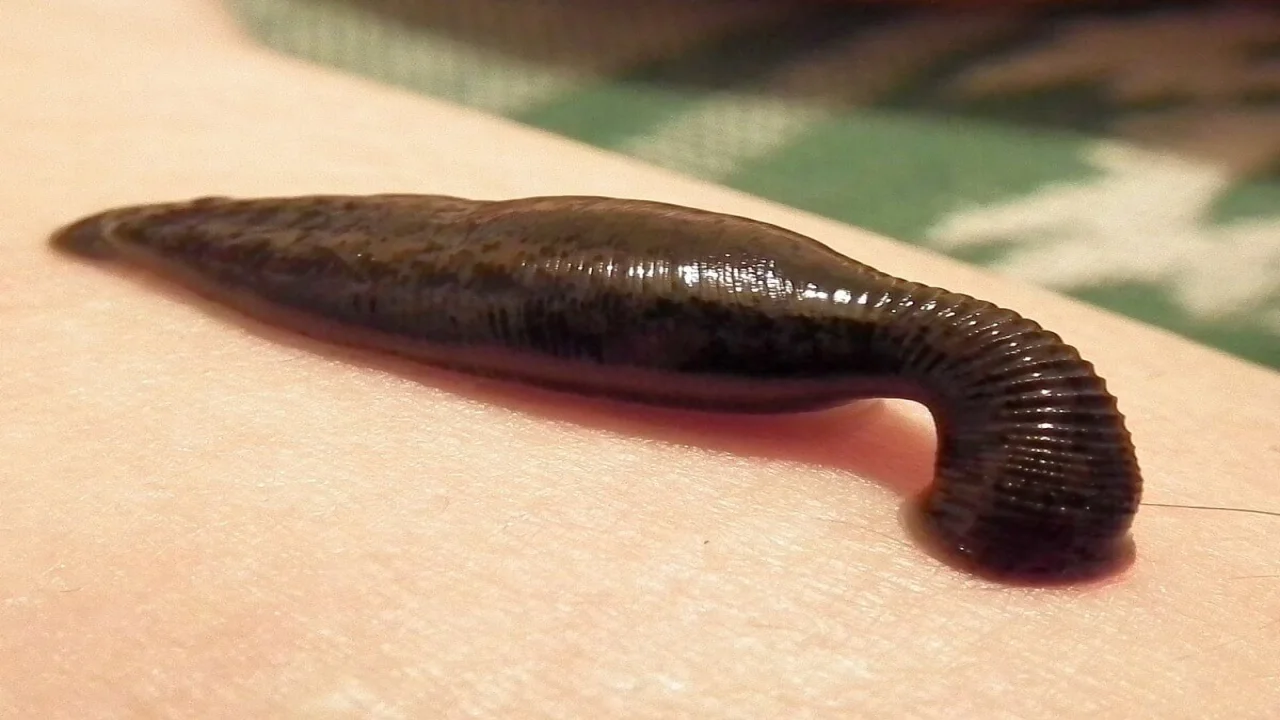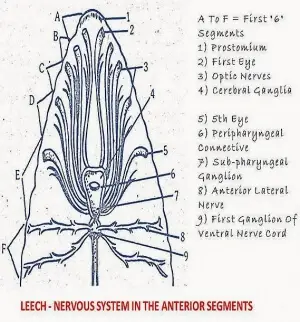Hirudinaria Nervous System Sense Organs
Hirudinaria, a leech species, possesses a complex nervous system with specialized sense organs. These organs enable the leech to detect changes in its environment, including temperature, light, and vibrations, facilitating navigation and prey detection.

The nervous system of Leech is annelidan but it shows advancement over the other annelids. It shows the central, peripheral, and autonomic nervous systems.
Central nervous system
It is enclosed in the ventral haemocoebmic canal. It shows.
- Cerebral ganglia and nerve ring
- Nerve cord
- Terminal ganglionic mass
The ganglia are made by nerve cells.
- Cerebral ganglia and nerve ring: On the pharynx in the fifth segment a pair of cerebral supra pharyngeal ganglia are present. They are fused. It is called the brain.
- Below the pharynx in the fifth segment sub-pharyngeal ganglionic mass is present. It is formed by the union of the 4 pairs of ganglia.
- The sub-pharyngeal ganglionic mass and Cerebro (or) supra-pharyngeal ganglionic mass will be connected by two circumpharyngeal connectives. Thus, a nerve ring is formed around the pharynx.
- Nerve cord: From the subpharyngeal ganglionic mass the nerve cord starts. It runs backward. It is mid-ventral in position. It is present below the posterior sucker. It will join the terminal ganglionic, mass present near the posterior sucker.
- The nerve cord shows 21 ganglia, one ganglion in the first annulus of each segment from the 6th to 26th segments of the body: Each ganglion is formed by the union of 2 ganglia. They give nerves or peripheral nerves. The nerve cord is made of nerve cells and nerve fibers.
- Terminal ganglionic Mass: In the posterior sucker of the leech terminal ganglionic mass is present. It is the fusion product of 7 pairs of ganglia.

Peripheral nervous system
From the ganglia of the central nervous system, many nerves will arise. These will constitute the peripheral nervous system.
- One pair of nerves will arise from the front side of the brain and go to the first pair of eyes and prostomium.
- Four pairs of nerves arise from the sub-pharyngeal ganglionic mass. They go to 2, 3, 4, 5th pairs of eyes.
- Two pairs of nerves arise from each ganglion and go to the body parts.
- Seven pairs of nerves will arise from terminal ganglionic mass and they go to the posterior sucker.
Autonomic nervous system
Below the epidermis, in the muscles, and on the alimentary canal nerve plexi wall is present. They join with peri pharyngeal connectives of the central nervous system. They also show a connection with multipolar ganglionic cells present in the gut wall.
Sensory Receptors of Leech
In leech, 4 kinds of sensory receptors are noticed. They are 1) Eyes 2) Free nerve endings 3) Annular receptors 4) Segmental receptors.
Eye
In leech, 5 pairs of eyes are present, in the first 5 segments One pair of eyes is in the first annulus of each segment. They are present on the dorsal side.
Structure
Each eye is a cup-like structure; it contains many large, light-sensitive cells in vertical rows. Each cell contains a lens, and the cytoplasm is a thin layer.
The nucleus is pushed to one side. Each eye is covered on the free surface by the cornea. Cornea is formed by transparent epidermal cells. Each eye is innervated by an optic nerve at the base.
Working
It is not known whether the image is formed in the eye or not. Variation in the sizes of the Eyes:
- The first and second pairs of eyes are the largest.
- The fifth pair of eyes will be the smallest.
The direction of the eyes
- The first pair of eyes will face forwards.
- The second pair of eyes will face forwards and outwards.
- The third and fourth pair of eyes will face backward and outwards.
- The fifth pair of eyes will face backward; because of this directional arrangement of eyes, the animal can receive light rays from all sides.
Free nerve endings
All over the body, these receptors are present. They are chemoreceptors. These are the nerve ends. These nerves will arise from the nerve cells present below the epidermis. They notice the chemical changes in the surroundings.
Annular receptors
In all the annuli of all the segments of the body of a leech, these receptors are present. They are tactile sense organs or they are called tango receptors. In each annual roughly 36 annular receptors are present. The receptor is looking like a papilla, its base is connected with nerve fiber.
Segmental receptors
The segmental receptors are larger than the annular receptors. They are few. They are present in the first annulus of each segment. 4 pairs on the dorsal side and 3 pairs on the ventral side.
Each segmental receptor is a papilla-like structure with a group of tall, slender cells. In between the cells, intercellular spaces are present. From the base of each cell, a nerve fibril will arise. All the nerve fibrils will unite at the receptor's base and become a nerve.
These receptors are tactile receptors. The dorsal segmental receptors work as tango and photoreceptors.
The information on this page is peer reviewed by a qualified editorial review board member. Learn more about us and our editorial process.
Last reviewed on .
Article history
- Latest version
Cite this page:
- Comment
- Posted by Dayyal Dungrela